#House of Cremonesi
Text

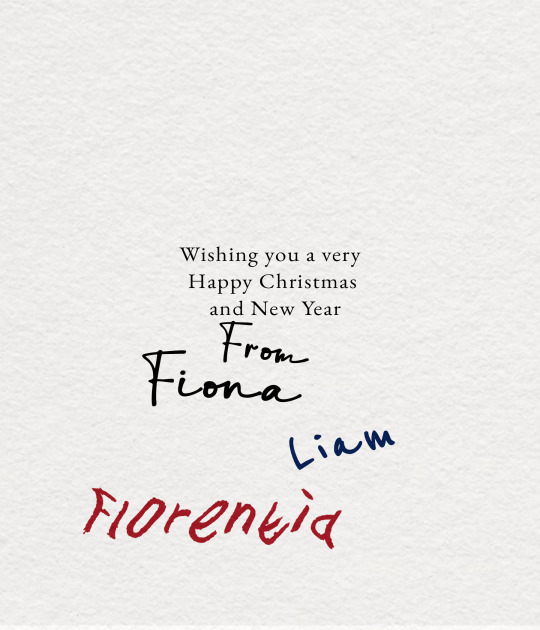

Past Cremonesi Family Christmas Cards (3/3)
The Mid-60s marked the dawn of the Fionan Era. After her father's death, The Former Queen rose to power amid her Pregnancy with her first child, Florentia. From this time to Mid 70s, her family life grew, and the rest of her children came along. The Annual card of the year, 2074, depicts just that. A laid-back image of a fresh, young family. A sign that the monarchy was stable and flourishing in a new age, despite discourse with the Vatican, underscored the adaptability of tradition to contemporary values even amidst disagreements with a seemingly archaic authoritarian influence.
After the disastrous events of the Crownsgate Scandal that unfolded in the year, 2117, the once idyllic image of Queen Fiona's laid-back family on the annual card became a poignant reminder of the fragility of stability. A reputation easily tarnished, A character irreversibly changed. Tragically deemed, "Fiona the Forgettable."
#ts4 storytelling#ts4 royal family#ts4 royals#ts4 royalty#royal sims#TheThronesStory#ts4story#sims story#sims storytelling#ts4 screenshots#ts4 story#ts4 legacy#House of Cremonesi#thecrimsonportraits#thethronesportraits#ChristmasCard#Christmas Special#Sim: Florentia#Sim: Fiona#Sim: Liam
42 notes
·
View notes
Photo



EXPERIMENT PROVIDES DEEPER LOOK INTO THE NATURE OF NEUTRINOS: CUORE EXPECTED TO REVEAL -- OR RULE OUT -- A POSSIBLE EXPLANATION FOR WHY THE UNIVERSE FAVORS MATTER OVER ANTIMATTER The first glimpse of data from the full array of a deeply chilled particle detector operating beneath a mountain in Italy sets the most precise limits yet on where scientists might find a theorized process to help explain why there is more matter than antimatter in the universe. This new result, published online at arXiv.org and submitted today to the journal Physical Review Letters, is based on two months of data collected from the full detector of the CUORE (Cryogenic Underground Observatory for Rare Events, https://cuore.lngs.infn.it) experiment at the Italian National Institute for Nuclear Physics’ (INFN’s) Gran Sasso National Laboratories (LNGS) in Italy. CUORE means “heart” in Italian. The Department of Energy’s Lawrence Berkeley National Laboratory (Berkeley Lab) leads the U.S. nuclear physics effort for the international CUORE collaboration, which has about 150 members from 25 institutions. The U.S. nuclear physics program has made substantial contributions to the fabrication and scientific leadership of the CUORE detector. CUORE is considered one of the most promising efforts to determine whether tiny elementary particles called neutrinos, which interact only rarely with matter, are “Majorana particles” -- identical to their own antiparticles. Most other particles are known to have antiparticles that have the same mass but a different charge, for example. CUORE could also help us home in on the exact masses of the three types, or “flavors,” of neutrinos -- neutrinos have the unusual ability to morph into different forms. “This is the first preview of what an instrument this size is able to do,” said Oliviero Cremonesi, a senior faculty scientist at INFN and spokesperson for the CUORE collaboration. Already, the full detector array’s sensitivity has exceeded the precision of the measurements reported in April 2015 after a successful two-year test run that enlisted one detector tower. Over the next five years CUORE will collect about 100 times more data. Yury Kolomensky, a senior faculty scientist in the Nuclear Science Division at Lawrence Berkeley National Laboratory (Berkeley Lab) and U.S. spokesperson for the CUORE collaboration, said, “The detector is working exceptionally well and these two months of data are enough to exceed the previous limits.” Kolomensky is also a professor in the UC Berkeley Physics Department. The new data provide a narrow range in which scientists might expect to see any indication of the particle process it is designed to find, known as neutrinoless double beta decay. “CUORE is, in essence, one of the world’s most sensitive thermometers,” said Carlo Bucci, technical coordinator of the experiment and Italian spokesperson for the CUORE collaboration. Its detectors, formed by 19 copper-framed “towers” that each house a matrix of 52 cube-shaped, highly purified tellurium dioxide crystals, are suspended within the innermost chamber of six nested tanks. Cooled by the most powerful refrigerator of its kind, the tanks subject the detector to the coldest known temperature recorded in a cubic meter volume in the entire universe: minus 459 degrees Fahrenheit (10 millikelvin). The detector array was designed and assembled over a 10-year period. It is shielded from many outside particles, such as cosmic rays that constantly bombard the Earth, by the 1,400 meters of rock above it, and by thick lead shielding that includes a radiation-depleted form of lead rescued from an ancient Roman shipwreck. Other detector materials were also prepared in ultrapure conditions, and the detectors were assembled in nitrogen-filled, sealed glove boxes to prevent contamination from regular air. “Designing, building, and operating CUORE has been a long journey and a fantastic achievement,” said Ettore Fiorini, an Italian physicist who developed the concept of CUORE’s heat-sensitive detectors (tellurium dioxide bolometers), and the spokesperson-emeritus of the CUORE collaboration. “Employing thermal detectors to study neutrinos took several decades and brought to the development of technologies that can now be applied in many fields of research.” Together weighing over 1,600 pounds, CUORE’s matrix of roughly fist-sized crystals is extremely sensitive to particle processes, especially at this extreme temperature. Associated instruments can precisely measure ever-slight temperature changes in the crystals resulting from these processes. Berkeley Lab and Lawrence Livermore National Laboratory scientists supplied roughly half of the crystals for the CUORE project. In addition, the Berkeley Lab team designed and fabricated the highly sensitive temperature sensors -- called neutron transmutation doped thermistors -- invented by Eugene Haller, a senior faculty scientist in Berkeley Lab’s Materials Sciences Division and a UC Berkeley faculty member. Berkeley Lab researchers also designed and built a specialized clean room supplied with air depleted of natural radioactivity, so that the CUORE detectors could be installed into the cryostat in ultraclean conditions. And Berkeley Lab scientists and engineers, under the leadership of UC Berkeley postdoc Vivek Singh, worked with Italian colleagues to commission the CUORE cryogenic systems, including a uniquely powerful cooling system called a dilution refrigerator. Former UC Berkeley postdoctoral students Tom Banks and Tommy O’Donnell, who also had joint appointments in the Nuclear Science Division at Berkeley Lab, led the international team of physicists, engineers, and technicians to assemble over 10,000 parts into towers in nitrogen-filled glove boxes. They bonded almost 8,000 gold wires, measuring just 25 microns in diameter, to 100-micron sized pads on the temperature sensors, and on copper pads connected to detector wiring. CUORE measurements carry the telltale signature of specific types of particle interactions or particle decays -- a spontaneous process by which a particle or particles transform into other particles. In double beta decay, which has been observed in previous experiments, two neutrons in the atomic nucleus of a radioactive element become two protons. Also, two electrons are emitted, along with two other particles called antineutrinos. Neutrinoless double beta decay, meanwhile -- the specific process that CUORE is designed to find or to rule out -- would not produce any antineutrinos. This would mean that neutrinos are their own antiparticles. During this decay process the two antineutrino particles would effectively wipe each other out, leaving no trace in the CUORE detector. Evidence for this type of decay process would also help scientists explain neutrinos’ role in the imbalance of matter vs. antimatter in our universe. Neutrinoless double beta decay is expected to be exceedingly rare, occurring at most (if at all) once every 100 septillion (1 followed by 26 zeros) years in a given atom’s nucleus. The large volume of detector crystals is intended to greatly increase the likelihood of recording such an event during the lifetime of the experiment. There is growing competition from new and planned experiments to resolve whether this process exists using a variety of search techniques, and Kolomensky noted, “The competition always helps. It drives progress, and also we can verify each other’s results, and help each other with materials screening and data analysis techniques.” Lindley Winslow of the Massachusetts Institute of Technology, who coordinated the analysis of the CUORE data, said, “We are tantalizingly close to completely unexplored territory and there is great possibility for discovery. It is an exciting time to be on the experiment.”
5 notes
·
View notes
Text
Libia, si tratta con chi non conta
Difficile tenere assieme Cirenaica, Tripolitania e Fezzan
di Mario Sechi Il Foglio.it – List
TripolItalia. Il problema lampeggia come una boa nel Mediterraneo dal 2011, si chiama Libia. È la portaerei dei trafficanti di uomini e così il buon ministro dell'Interno Marco Minniti va a Tripoli per un accordo bilaterale con il governo di Tripoli. Ottimo. Spacchettiamo la notizia.
Alfa non c'è. Dopo le intervistone dove annunciava accordi dall'Alpi alle Piramidi, dal Manzanarre al Reno (Giacomo Manzoni, uno stuntman della letteratura), come sempre arriva la realtà: Angelino Alfano, il Kissinger di Agrigento, è certamente da qualche parte, ma non in Libia. Chi comanda? In Libia chi ha lo scettro? Il governo onusiano di Al Serraj? La risposta è no. Il Corriere della Sera, l'altro ieri, ha pubblicato un'ottima intervista di Lorenzo Cremonesi al generale Khalifa Belqasim Haftar. È lui che comanda, non solo in Cirenaica, ma in gran parte della Libia. Haftar dixit: «L'Italia in Libia si è schierata dalla parte sbagliata». In linea con la nostra tradizione storica: vediamo un vincente, due minuti dopo è il perdente.
Chi è Haftar? Una vecchia conoscenza di Gheddafi (prima alleato e poi avversario), della Central Intelligence Agency (Haftar abitava a Langley, a pochi passi dal «bosco» e una sua milizia fu creata e finanziata dalla Cia nel 1990 in Chad) e dell'Egitto. Haftar si muove con l'appoggio di Al Sisi (Egitto), il 27 novembre scorso è stato ricevuto con tutti gli onori a Mosca dal ministro degli Esteri Sergey Lavrov (Russia), ha ottimi rapporti con re Hussein (Giordania), Un po' di storia del generale la potete leggere in questo profilo scritto nel 2014 dal titolare di List.
La Libia è uno Stato? La risposta la troviamo a Londra, in questa audizione alla House of Lords del 7 luglio scorso. Parla l'ambasciatore britannico a Tripoli, Lord Millet, gli esiti sono tragicomici. Domanda di Lord Horam: «È vero che c'è una crisi di liquidità in Libia?”. Risposta di Mr. Millett: L'ho visto la scorsa settimana a Tripoli. Alle otto del mattino, durante il Ramadan, c'erano lunghe code di persone fuori dalle banche che cercavano di incassare i loro stipendi.
La Banca Centrale mi ha detto che in Libia circola un numero di banconote pro-capite doppio rispetto a quello del Regno Unito.Domanda di Lord Horam: È vero che le nascondono nei materassi? Risposta di Mr. Millett: Esatto. L'azienda inglese che stampa il Dinaro, De La Rue, ha recentemente fornito un altro miliardo di Dinari. È svanito nel sistema, ma il vero problema da affrontare non è quello di stampare più moneta, è quello di costruire fiducia e sicurezza.
Domanda di Lord Stirrup: Per la gran parte della sua storia, la Libia non è mai esistita. Ci sono sempre state tre province separate (Cirenaica, Tripolitania e Fezzan) con i regni islamici e con l'impero Ottomano. La Libia come la immaginiamo è una costruzione molto recente. Pensa che esistano sufficienti idee unificanti, siano esse di coesione interna o pressione esterna, per mantenere insieme il paese, un qualsiasi schema di collegamento da applicarvi sopra?
Risposta di Mr. Millett: Questa è davvero una sfida di lungo termine. Ha ragione, in Libia ci sono tre regioni. I libici si riconoscono, prima di tutto e innanzitutto, con la loro famiglia, la loro tribù, la loro città e la loro regione. Al momento, l'interesse nazionale e l'unità nazionale non sono fattori unificanti.
La situazione in Libia è migliorata da quando fu deciso l'attacco al regime di Gheddafi? No. Serraj non ha alcun esercito reale a disposizione. E l'intervista di Haftar sul Corriere è la spia rossa accesa dentro il sommergibile.
È probabile che il generale tenti di prendersi tutto il potere in Libia attaccando gradualmente, prima annientando le milizie a Misurata e poi prendendo Tripoli dove, in realtà, non comanda nessuno. Scetticismo del titolare di List? Per sapere e per capire il caos che regna a Tripoli, leggete questa cronaca del Lybia Herald: Serraj è assente, a Londra per una vacanza in famiglia, torna a Tripoli e cancella tutte le nomine ministeriali prese dal suo vice. Seguono dimissioni a catena. Il ministro Minniti va a discutere con l'ectoplasma di un governo.
Tutto chiaro? La Stampa fa questo titolo d'apertura: «Intesa con Tripoli per i migranti. Il piano italiano». Ma è il catenaccio a rivelare la verità sulla situazione: «La difficile missione di Minniti. Bozza pronta, dubbi su Serraj». Con questi dubbi (che in realtà sono le certezze della cronaca, basta leggerla) in Italia avanza un piano per riaprire i centri di identificazione ed espulsione (Cie) in tutte le regioni. Si può fare? Sì. Funzionerà? Non lo sappiamo, finora l'Italia ha fatto un egregio lavoro in mare a cui è seguito il caos a terra. Stato, Regioni e Comuni hanno voci diverse, manca una visione d'insieme, domina la propaganda.
Basta fare un viaggio in tipografia per rendersene conto. Titolo d'apertura del Corriere della Sera: «Così sono fallite le espulsioni». No news. Repubblica fa questo titolo che ha il dono della chiarezza e mette un numero sulle idee del governo Gentiloni: «In ogni Cie 100 migranti». Il Messaggero va giù con un titolo piatto: «Espulsioni, ecco le nuove regole». Il paese che risolve tutto in 24 ore, un miracolo. Il Giornale punta sul portafoglio: «Paghiamo un miliardo per farci invadere». È il costo delle coop per l'accoglienza.
La realtà è che siamo in pieno ciclo elettorale e il governo è in perenne zona rossa, quella dell'emergenza. Senza riforme. È un drammatico indietro tutta, i segnali sono ovunque.
Il tappabuchi. Il prossimo governo che uscirà dalle urne avrà un solo compito, quello del tappabuchi. Titolo di taglio sulla Stampa: «Pronti 1,8 miliardi per la legge antipovertà». È un'intervista a Tommaso Nannicini, economista, ieri a Palazzo Chigi al fianco di Renzi, oggi nella segreteria del Pd sempre a fianco di Renzi. Nannicini è bravo, ha solo un problema: annuncia cose che costano e non hanno alcun senso della realtà del paese. Quasi due miliardi per i poveri (quelli che escono dalle dichiarazione dei redditi? stiamo freschi), siamo all'inseguimento di Grillo su reddito minimo et similia, un altro provvedimento elettorale in un paese ad alto tasso di evasione e furberia quotidiana. Nannicini ci deliziò l'estate scorsa con il fondamentale dibattito ferragostano sulla pensione anticipata, quello dal nome che era un programma da bar, l'Ape. Si va avanti così, la spesa di oggi è il conto di domani.
E i ceti produttivi? Le imprese? Si continua a finanziare un paese immobile: pensionati, pensionandi, dipendenti della pubblica amministrazione. Titolo sul Resto del Carlino: «Boccia: ora nuove riforme». È un'intervista al presidente di Confindustria Vincenzo Boccia che con il sottofondo di chi ha un tremendo sospetto dice: «No a mesi di inerzia».
Caro Presidente, legga Nannicini sulla Stampa, c'è la risposta sui prossimi mesi. Tranquilli, i patrioti guidati dal ministro Calenda risolveranno tutto e fa niente se in Italia il 2016 si è chiuso in deflazione (non succedeva dal 1959) e la pressione fiscale – come ha ricordato Vito Tanzi sul Foglio – «è circa 15 punti del pil, al di sopra degli Stati Uniti e del Giappone, e circa 10 punti al di sopra del Regno Unito». Come si dice in questi casi? La mia spesa è il reddito di un altro. Solo che è a senso unico. Io spendo, l'altro incassa.
Preso da: http://ift.tt/2imRKHG
http://ift.tt/2iOoxGD
0 notes
Text



Happy New Year | From the Cremonesi's
As the last seasonal special, it's time for the yearly spoiler. And as usual, this might not be promised. But nevertheless, I can hope for their happiness.
-Happy New Year! (and super late 2 year anniversary!!)
Original Image under cut

#ts4 storytelling#ts4 royal family#ts4 royals#ts4 royalty#royal sims#ts4story#sims story#sims storytelling#ts4 screenshots#ts4 story#ts4 legacy#House of Cremonesi#Thethronesportraits#TheCrimsonPortraits#ttedits#ts4edits#sims 4 edit
38 notes
·
View notes
Text




The Leiden Family
I love this family to bits, they're so lovely together. These pictures were taken in their beautiful country home, Freesia Manor. It was built by the talented @wa-royal-tea! I seriously can't wait for the next arc to begin so I may show more of their dynamics.
Pictures include: Florentia, Princess of Leiden; Dorian, Prince of Leiden; Prince Aurelio of Leiden.
#the garden is my favorite spot clearly!! like look at those pictures 😭#TS4 SCREENSHOTS#TS4 LEGACY#HOUSE OF CREMONESI#THECRIMSONPORTRAITS#THETHRONESPORTRAITS#TS4 ROYALTY
20 notes
·
View notes
Text
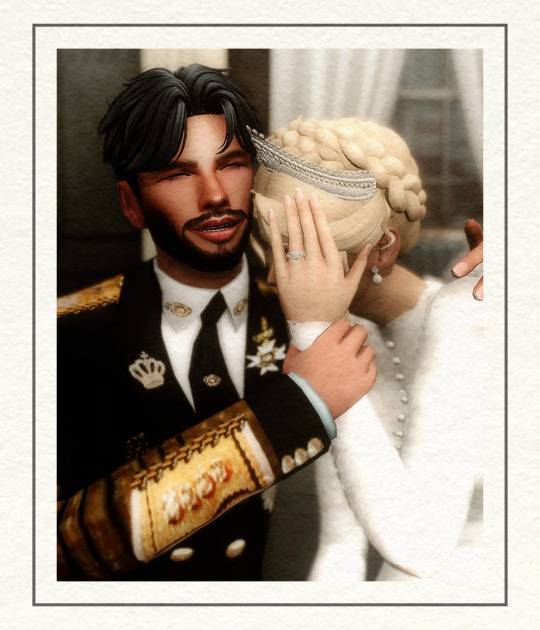


Past Cremonesi Family Christmas Cards (2/3)
2034, (a year after the youngest, Duke Elliot, passed away) was a year of heavy controversy for the Orillian Royal Family, Particularly with the Cremonesi Triplets. Prince Conan, Second in Line, abdicated from his position in the line of succession, a rash decision by the Prince, who later went on to regret his actions. In retaliation, he wooed, then Tsesarevna [heir apparent] of Valrovia, Tsarina Alice Sokolov.
The tumultuous love life of Princess Honoria was widely regarded by most, if not all Orillians as a failure. The Princess, Third in line (second after her brothers abdication), was free to explore her passions in ways her siblings never could. Pursue them she did, in a particular Edmund Scutari. By the end of 2034, Edmund divorced his wife and asked for Honoria's hand. In 2039, she went on to marry Sultan Dario Osmanoğlu.
But most historic of all, 2034 was the year of Crown Prince Oliver of Orillia and Princess Ila of Valrovia's wedding. The two christened their love in winter of the year, and understandably so, was met with large criticism. Ila and Oliver had an 11 year age gap, Ila being 19 and Oliver being 30. This years Christmas card was the first to have two variations. And it depicted the couples various moments of candid activity.
While the couple struggled in their first decade of marriage with one another and with their fertility. They welcomed their daughter, Princess Fiona 8 years into their marriage in the year 2042.
poses by @cattermelons
#ts4 storytelling#ts4 royal family#ts4 royals#ts4 royalty#royal sims#TheThronesStory#ts4story#sims story#sims storytelling#ts4 screenshots#ts4 story#ts4 legacy#House of Cremonesi#thecrimsonportraits#thethronesportraits#ChristmasCard#Christmas Special
46 notes
·
View notes
Text
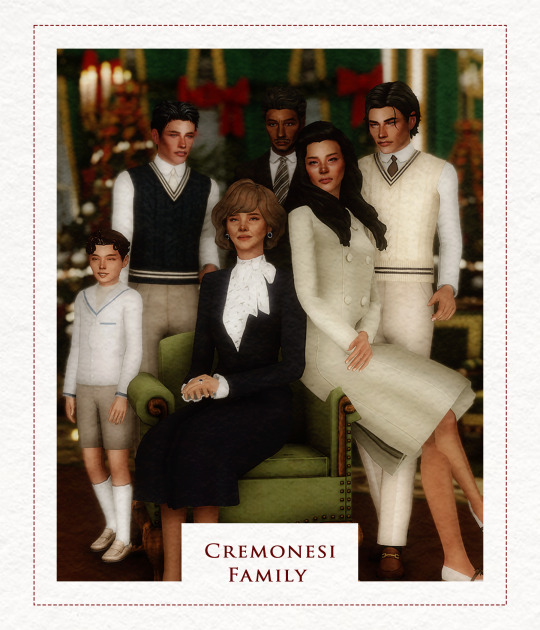


Past Cremonesi Family Christmas Cards (1/3)
In the year 2019, The Cremonesi Royal Family released their Annual christmas card. The Card featured the family with their newest addition, Duke Elliot Dumitrescu De'Cremonesi. Royal watchers and critics alike have speculated on the origins of the honorary Prince. Some claiming that he was the illegitimate son of either the King or the Queen, A political alliance, a symbol of unity between the ever widening gap of classes, and the possible child of the King first marriage with Former Queen Maddalena turned mistress. While there was a lot of speculation (some more far fetched than others) , none of them were ever confirmed. Years later, Elliot was the first to pass away among his siblings, in the year 2033 at the age of 22.
The other individuals in the image were Queen Fernanda, Princess Honora "Nora", Crown Prince Oliver, King Milano, and Prince Conan. The Triplets were, 15 at the time.
#ts4 storytelling#ts4 royal family#ts4 royals#ts4 royalty#royal sims#TheThronesStory#ts4story#sims story#sims storytelling#ts4 screenshots#ts4 story#ts4 legacy#House of Cremonesi#thecrimsonportraits#thethronesportraits#ChristmasCard#Christmas Special
34 notes
·
View notes
Text

Happy Holidays from their family to yours.
#House of Crimson#ts4 storytelling#ts4 royal family#ts4 royals#ts4 royalty#royal sims#TheThronesStory#ts4story#ttextras#TheCrimsonPortraits#TheThronesPortraits#Christmas Special#Sim: Aurelio Cremonesi#sim: florentia#sim: dorian
18 notes
·
View notes
Text









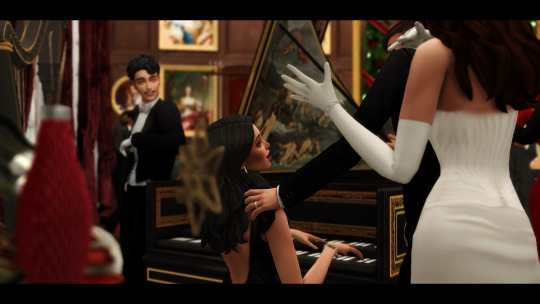


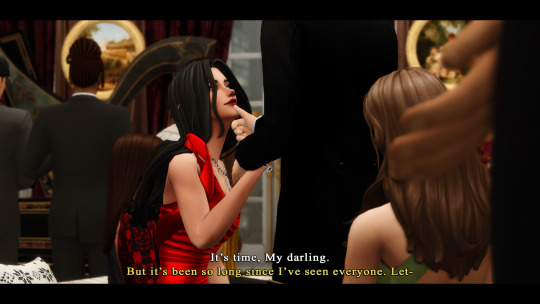

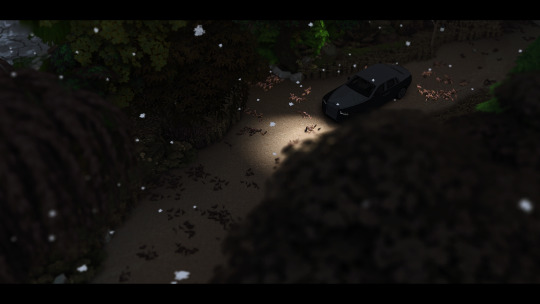



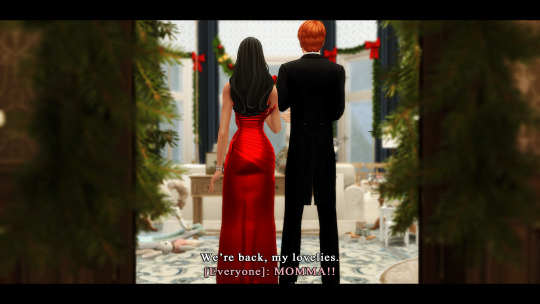










The Royal Thrones Christmas Special - An Ideal Future
beginning | previous | next
This Christmas special takes place a few years in the future. It's called an ideal future because nothing that is shown is promised.
Happy Holidays
-Gigi
#House of Crimson#ts4 storytelling#ts4 royal family#ts4 royals#ts4 royalty#royal sims#TheThronesStory#ts4story#ttextras#TheCrimsonPortraits#TheThronesPortraits#Christmas Special#Sim: Aurelio Cremonesi#sim: florentia#sim: dorian
36 notes
·
View notes
Text

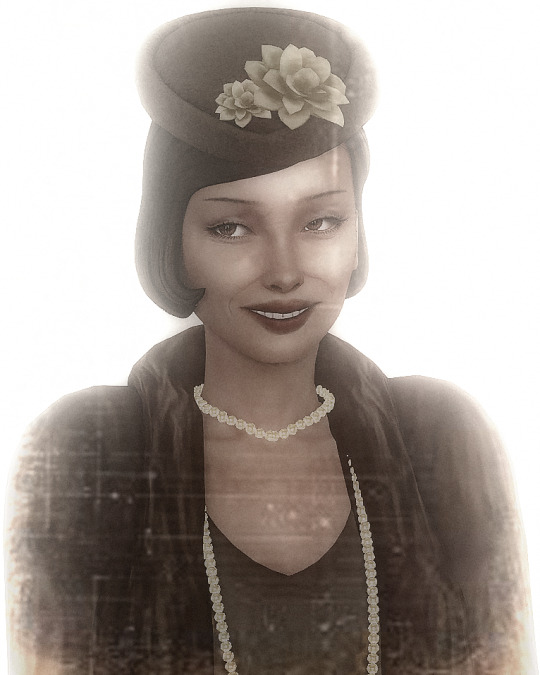






Orillian Queens, Almost Queens, and Consorts of the 20th Century

Queen Consort Morosina De'Cremonesi-Grimani circa 1861-1932
Born as the second daughter of the Viscount of Trieste, Lady Morosina was considered plain in looks and thought. This characterization was paid no mind to a certain prince, who overlooked her beauty to instead gaze upon the immense riches of her father. Married to a man two decades her senior, she was famously unhappy. Many considered her a prude, drab, and a woman who didn't deserve the fortune of marrying into the coveted De Cremonesi House.
Queen Vittoria De'Cremonesi circa 1890-1943
The only Queen of the 20th century, Vittoria made a name for herself in all the ways that didn't matter. She spent her days living lavishly under the jewels and lights of the Jazz Age. Her parties were known far and wide. The most notorious names of the time graced her halls. Anyone of any birthright, class, talent, or profession could gain an invitation. Famously, when asked about the very topic she replied, "Let them sip champagne and dance; to a beggar, even a fortune is worth only these crumbs." This being said during a time of need.
Queen Consort Georgiana Della Rovere circa 1935-1982
Everyone knew Georgiana Della Rovere was born a star, and so she made herself such. Born in the Cagliari province to a doctor and nurse, she fought to break out of the expectations of her parents. And make a name for herself. She became a model, a variety show hostess, and finally a leading star. She was an influential idol of the 50s and 60s. Georgiana had a very colorful life, she was married four times – Twice to the same man – and for the last time, she married a prince.
Lady Madelaena Sforza circa 1960-2023
"The Queen who would never be," is a title she earned with her infamous divorce to then, Prince Milano De'Cremonesi. A Sforza from birth, betrothed to a prince since her sixth year, she was no stranger to the complexities of her "high society". How to act, what to say, how to treat and be treated. It came as no surprise when she walked in on her husband and her lady-in-waiting. "This is what they do, the men," everyone told her. But unlike the women in her station before her, she wouldn't stay silent. Some may agree that she may have milked the affair far too long, but none would deny reputations destroyed and the scandal that came with the campaign: A book, interviews, confessions of infidelity, and the iconic revenge dress.
Queen Consort Fernanda De'Cremonesi-Adragna circa 1965-2049
Lady Fernanda Adragna was disgraced from a very young age. If you asked her the reason at 6 she'd repeat, "An Adragna is never fortunate," if you asked at 18 she'd cry, "parent's divorced, father imprisoned, embezzlement a sin," and if, years later, you ever found the chance to ask again. She might mention a prince, an affair, a baby, and a wedding. With a past like hers, no one could blame her for her reputation. Her husband loathed her, her children tolerated her, and people whispered.

#ts4 storytelling#ts4 royal family#ts4 royals#ts4 royalty#royal sims#TheThronesStory#ts4story#sims story#sims storytelling#ts4 screenshots#ts4 story#ts4 legacy#House of Crimson#TheCrimsonPortraits#TheThronesPortraits#sim: fernanda#sim: georgiana Della Rovere#sim: Madelaena#sim: vittoria#sim: Morosina
22 notes
·
View notes
Text
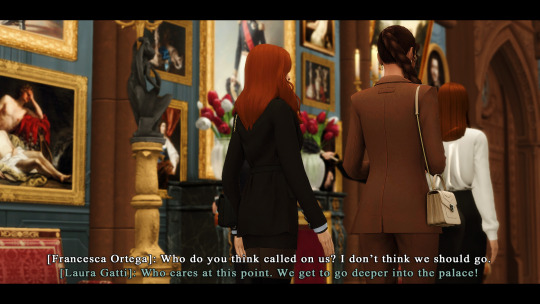












Behind the Scenes | Unexpected Reunions |Capri, Orillia
beginning | previous | next
~Transcript~
FRANCESCA ORTEGA
Who do you think called us?I don't think we should go.
LAURA GATTI
Who cares at this point. We get to go deeper into the palace! This place is a dream.
STAFF
Right this way, Ma'am. Don't forget to bow.
STAFF
Mrs. Gatti and Ms. Ortega. Meet his Royal Highness, Prince Lucian.
LUCIAN CREMONESI
I can't believe it. I knew it was you.
LAURA GATTI
Good Afternoon, Your Royal Highness. I apologize, but I don't think we've met before.
LUCIAN CREMONESI
Cici, It's been a while.
FRANCESCA ORTEGA
It has.
LUCIAN CREMONESI
What happened to you? And how did I not know you were in Orillia now?
FRANCESCA ORTEGA
Life happened, I guess. And you never told me you were a Prince.
(We're not going to talk about it? Not today)
LUCIAN CREMONESI
It wasn't important. Especially at Britchester.
LAURA GATTI
You know each other?
FRANCESCA ORTEGA
No
LUCIAN CRIMSON
No?
LUCIAN CREMONESI
Yes, Mrs. Gatti. We went to university together.
FRANCESCA ORTEGA
As if thats all.
LUCIAN CREMONESI
Well is all you've ever admitted. At least before you disappeared.
FRANCESCA ORTEGA
Is this why you called me here? I had my reasons, Lucian. We're leaving.
LUCIAN CREMONESI
Wait no, I'm sorry. I actually want to catch up. How about you come to a party my sister is hosting at her house? Be my guest. It's a week away.
FRANCESCA ORTEGA
I have to take care of my sister. But thank you.
LUCIAN CREMONESI
You can bring her too. I'll have my assistant send you a car. Please Cici?
FRANCESCA ORTEGA
Maybe.
#ts4 storytelling#ts4 royal family#ts4 royals#ts4 royalty#royal sims#TheThronesStory#ts4story#House of Crimson#Sim: Francesca Ortega#Sim: Laura Gatti#Sim: Lucian Crimson#sims story#sims storytelling#ts4 screenshots#TheLiars
19 notes
·
View notes